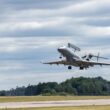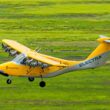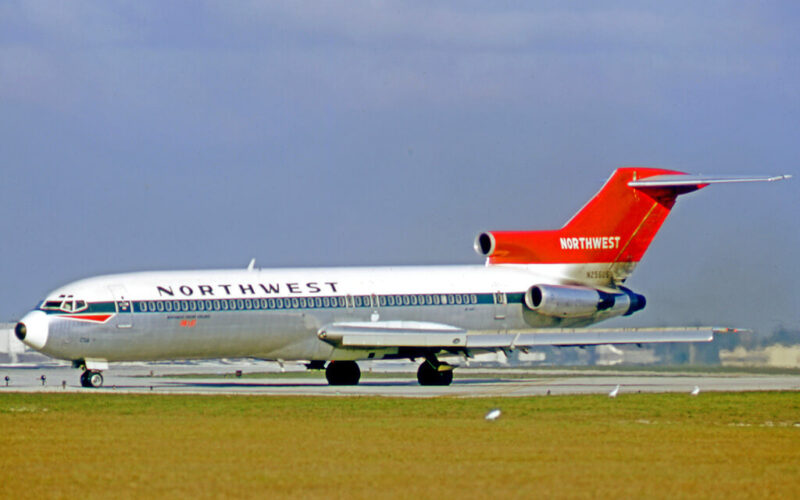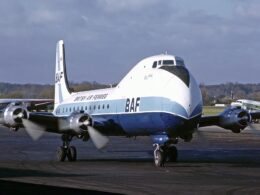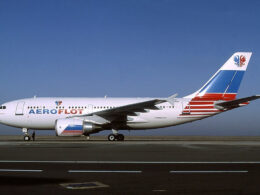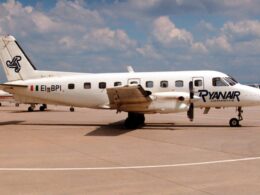Hijackings are now considered a rare occurrence. Unfortunately, during the 20th century, they were much more common compared to today. However, it was unusual for a hijacking case to remain unsolved, especially to this day.
But this is exactly what happened after one man took a Boeing 727 hostage. The plane belonged to Northwest Airlines and has been flying from Portland International Airport (PDX) to Seattle Tacoma International Airport (SEA) on November 24, 1971, when the hijacking took place.
That man was called D.B. Cooper, according to news agencies, or Dan Cooper, which was the name printed on his one-way ticket between the two cities in the Pacific Northwest – and allegedly an alias. [EY2]
While he was never found again, Cooper left a mark on aircraft design and became a true cult hero. A mechanism called the Cooper Vane, an aerodynamic device that prevents airstairs from deploying while mid-air, was installed on all Boeing 727 aircraft after the Federal Aviation Administration (FAA) issued a notice of proposed rulemaking on June 20, 1972.
“Specifically, it is proposed to amend Sec 25.809 to provide that, when required by the operating rules, for any large passenger carrying turbojet powered air-plane an approved means must be provided so that: (1) takeoff cannot be started if either the ventral exit or tail cone exit is not locked; and (2) neither the ventral exit nor the tail cone exit can be opened in flight.”
But what happened on November 24, 1971?
“A very cool” hijacker
That is how The Free Lance-Star, a newspaper in Fredericksburg, Virginia described the hijacker, who was reportedly dressed in a business suit and a raincoat.
The same “cool” hijacker purchased a one-way ticket for $20 from Portland to Seattle, a 30-minute flight on a Boeing 727. Mid-air, Cooper passed a note to the flight attendant, informing her that his suitcase contained a bomb. Later, he stated his demands: four parachutes, $200,000 in $20 bills and a flight to Mexico. As the tri-engine jet landed in Seattle, authorities handed him his parachutes and money in exchange for the freedom of 36 passengers. Following a fuel top-up, the 727 took off for Mexico City, flying just under 10,000 feet (3048 meters) at a speed of around 200 knots (230 miles per hour/370 kilometers per hour). Four crew members: two pilots, one flight engineer and one flight attendant remained onboard.
Shortly after taking off, Cooper, who the Federal Bureau of Investigation (FBI) described as a mid-40s male, measured between 5’10” and 6’ (177 and 182 centimeters) and apparently a heavy smoker of Raleigh filter cigarettes, jumped out of the aircraft using one of the parachutes, somewhere between Portland and Reno, Nevada, United States. Prior to the jump, the hijacker asked the single remaining flight attendant to show him how to open the aft door.
“It would be a very safe drop,” a Boeing official explained to a news reporter in 1971, due to the fact that the altitude did not require the aircraft to be pressurized – Cooper would not have lost consciousness upon the opening of the stairs. In its vault archives, the FBI notes that the captain received a signal in the cockpit, which indicated that the airstairs were lowered. A few minutes after, the pilots experienced oscillation, marking the moment when the elusive man jumped out of the Boeing 727. Seemingly, Cooper chose the perfect day to commence his crime, as the weather was overcast with extremely low visibility.
“Air Force fighter planes were escorting the craft but because the 727 was flying at 170 knots, the fighter jets were too fast,” notes the official FBI report, nicknamed NORJAK, consisting of 42 parts and thousands of pages.
“If he is in the area… we will dig him out of the woodwork somehow,” an FBI spokesperson promised shortly after the incident occurred, The Free Lance-Star reported in 1971.
Clues were too far and far between. Before jumping, Cooper left his tie on board, giving the investigators a DNA sample to work with. A major breakthrough came in 1980, when a then-eight-year-old boy, Brian Ingram, found a stack of $20 bills near the Columbia River. The bills amounted to $5,800 (adjusted for inflation, $18,000 in today’s money) and matched the serial numbers of the cash given to Cooper. A New York Times report from 1986 indicated that Ingram kept $2,760 of the cash he found, with another $2,760 going to the insurance company of Northwest Airlines. Investigators kept $280 worth of $20 bills for evidence.
But the evidence amounted to nothing. The FBI indicates that over 800 suspects were investigated for the crime, with all of them being ruled out. Perhaps one of the most interesting theories, which the Bureau also explored, is that D.B. Cooper allegedly worked for Boeing. It originated after the investigators received a tip from another Boeing employee, which pointed to the fact that the potential suspect looked “an awful lot like the composite photograph of D.B. Cooper” and had “a vast knowledge regarding Boeing 727 aircraft” and had “prior parachuting experience”.
In 2016, the FBI announced that following an investigation, which was one of the “longest and most exhaustive investigations” in the Bureau’s history, the agency is redirecting resources allocated to Cooper’s case “in order to focus on other investigative priorities.” The case was closed without a final verdict, with D.B. Cooper remaining a mystery of a man that eluded the authorities for over 40 years. However, a small glimmer of hope remains, that maybe one day the identity behind the hijacker will be dug out of the woodwork:
“Although the FBI will no longer actively investigate this case, should specific physical evidence emerge — related specifically to the parachutes or the money taken by the hijacker — individuals with those materials are asked to contact their local FBI field office,” concluded the agency.
Nevertheless, while the true identity of the hijacker remains a mystery, he has become a hero in the eyes of many. There is even a two-day festival dedicated to the escapee, called CooperCon. Held in Vancouver, Washington, United States, it includes multiple speakers, a movie, an escape room and a road tour – the three aforementioned items on the agenda are all dedicated to D.B. Cooper. Multiple authors wrote books about the hijacking and a radio drama, titled “In Flight with DB Cooper” saw daylight on November 27, 2019, as well as ”The Skyjacker”, published on November 25, 2020.
The article was first published on AeroTime on November 22, 2019.

